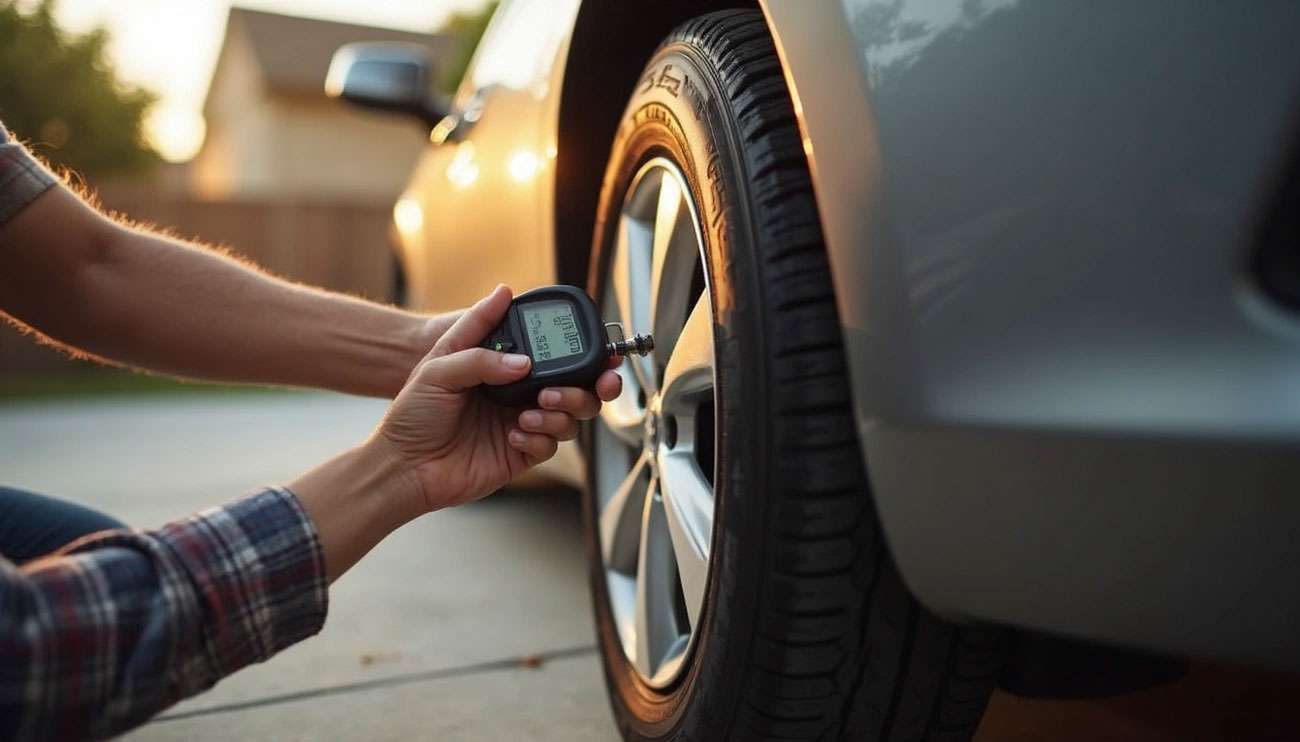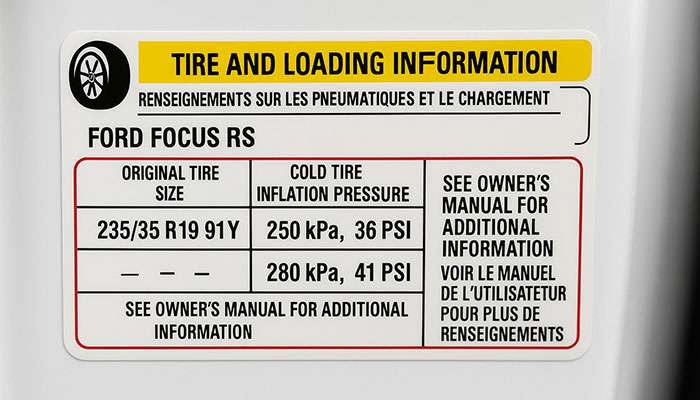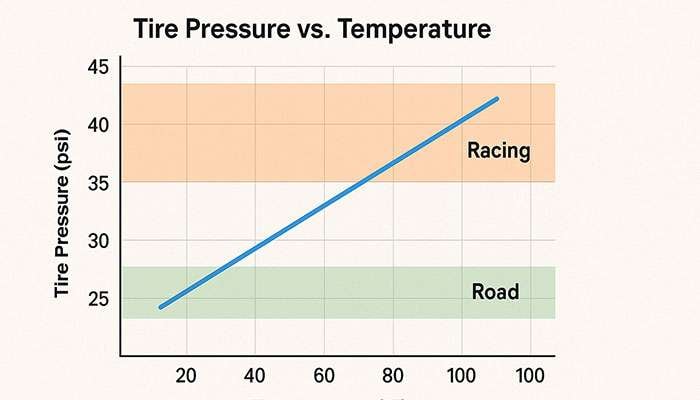
Your recommended tire pressure changes by 1 PSI for every 10°F shift in temperature. This simple fact affects every driver, yet most people don't realize how dramatically temperature swings impact their vehicle's safety and performance.
Winter months bring the biggest challenges. Your tires lose nearly 5 PSI as temperatures drop, creating serious problems with traction, handling, and tire life. The National Highway Traffic Safety Administration reports that underinflated tires rank among the leading causes of tire failure. When your tires run low on air, they create excessive rolling resistance that forces your engine to work harder and burn more fuel.
Most passenger cars require between 32 to 35 PSI when tires are cold, but many drivers never check this crucial specification for their specific vehicle. The consequences add up quickly: underinflated tires wear out faster, handle poorly, and waste gas with every mile you drive.
We'll show you exactly where to find your vehicle's recommended tire pressure, the right way to check it, and why proper PSI maintenance goes far beyond saving money at the pump. This simple knowledge could save your life on the road.
Proper tire pressure forms the foundation of vehicle safety and performance. Understanding these key benefits helps you make informed decisions about tire maintenance.
Your tire pressure directly affects how much you spend at the gas pump. Research proves you can improve gas mileage by up to 3.3% simply by maintaining proper tire inflation. For every 1 PSI drop across all four tires, you lose about 0.1% of your gas mileage. These numbers add up quickly—underinflated tires waste approximately 5 million gallons of gas daily in the United States alone.
The Oak Ridge National Laboratory study reveals even more dramatic impacts. Tires running at just 50% of recommended pressure reduce fuel economy by about 10% at 40 mph. Even at 75% of proper pressure, vehicles still suffer a consistent 2-3% fuel economy penalty.
Recommended tire pressure ensures optimal contact between your tires and the road surface. This contact zone determines how well your vehicle responds to your inputs. Underinflated tires create a sluggish, unresponsive feeling when you turn or brake. Your steering becomes less precise and emergency stopping distances increase significantly.
Properly inflated tires deliver better traction and grip, especially when you need to make sudden maneuvers. This enhanced responsiveness can mean the difference between avoiding an accident or being involved in one.
Correct tire pressure substantially extends how long your tires last. Underinflated tires create excessive contact with the road surface, generating heat and causing uneven wear on the outer edges. Overinflated tires wear more rapidly in the center.
Every PSI you lose means your tires wear approximately 10% faster. With proper inflation, tires wear evenly and last significantly longer, saving you money on premature replacements.
Proper tire pressure dramatically reduces your risk of experiencing a dangerous blowout. Underinflated tires flex excessively while rolling, generating heat that weakens the rubber structure. This process can lead to tread separation and complete tire failure.
The National Highway Traffic Safety Administration reports nearly 11,000 tire-related crashes occur each year—many resulting from underinflation. A blowout at highway speeds often causes drivers to lose control, potentially resulting in serious accidents.
Maintaining recommended tire pressure isn't just about optimizing performance—it's about protecting yourself and others on the road.

Finding your vehicle's correct tire pressure takes less than five minutes when you know where to look. Every vehicle has this essential information stored in specific locations designed for easy access.
Your driver's side door area holds the most important tire information for your vehicle. Open the driver's door and look at the door frame, door edge, or door jamb. You'll find a placard or sticker that lists your tire sizes along with the recommended cold tire pressure for both front and rear tires. Some manufacturers place this information on the door's rear edge, inside the glove box, or on the fuel-filler door.
This placard provides the exact specifications calculated for your vehicle's weight and handling characteristics. The numbers here represent what your vehicle needs for optimal performance and safety.
When you can't locate the door placard, your owner's manual serves as the definitive source for tire pressure specifications. The manual contains detailed information specific to your model, including recommended cold tire inflation pressure in PSI (pounds per square inch) or kPa (kilopascals). You'll often find additional guidance about maintaining proper pressure under different driving conditions.
Many vehicles require different pressures for front and rear tires. Automakers determine these recommendations based on vehicle weight, load capacity, and tire size. Front tires often need higher pressure because most vehicles carry more weight at the front due to engine and transmission placement. However, some vehicles specify higher rear tire pressure, particularly when carrying heavy loads.
These pressure differences ensure balanced handling and even tire wear across all four tires.
The pressure number on your tire's sidewall represents the maximum safe inflation pressure the tire can handle, not your recommended pressure. This maximum safe inflation pressure figure appears much higher than what your vehicle actually needs.
Always use the specifications from your door placard or owner's manual instead. These numbers reflect the optimal pressure calculated specifically for your vehicle's weight, handling, and performance needs. Using the sidewall maximum creates problems with handling, comfort, and uneven tire wear.
Once you know your vehicle's recommended tire pressure, checking and adjusting your tires becomes straightforward. These steps ensure you get accurate readings and maintain optimal performance.
A reliable tire pressure gage gives you better accuracy than most gas station air pumps. Digital gages typically provide more precise readings than analog versions. Press the gage firmly onto the valve stem until you hear the hissing stop. Read the PSI number and compare it to your vehicle's specification. Check each tire two or three times to verify accuracy.
Tire pressure readings change dramatically with heat. Always check when tires are "cold"—first thing in the morning or after your vehicle sits for at least three hours. Driving heats up your tires and gives you falsely high readings. If you must check warm tires, expect them to read about 4 PSI higher than the cold specifications.
Adding air requires a firm connection between the air hose and valve stem. Press the nozzle on until you hear air flowing. Check pressure frequently while filling to avoid overinflating your tires. When you need to release air from overinflated tires, use the back of your gage or a small tool to press the valve stem's center pin. This lets air out gradually until you reach the correct PSI. Always replace the valve cap when you finish.
Your spare tire needs monthly attention just like your regular tires. Full-size spares should match the PSI of your other tires. Temporary "donut" spares require much higher pressure—usually 60-80 PSI according to your manual.
Your tire pressure monitoring system might stay illuminated even after proper inflation. Try driving at 50+ mph for 10 minutes to reset the system. Look for the TPMS reset button, typically located under your steering wheel. Some vehicles require disconnecting the battery briefly. Check your owner's manual for specific reset procedures since methods vary by manufacturer.

Even perfectly maintained tires experience pressure fluctuations throughout normal use. Understanding what affects your tire pressure helps you stay ahead of problems before they impact your vehicle's performance or safety.
Cold weather creates the most dramatic pressure drops. For every 10°F change in ambient temperature, tire pressure changes by approximately 1-2 PSI. Throughout winter months, your tires could lose nearly 5 PSI as temperatures drop. Daily fluctuations matter too—tire pressure measured in the morning might be almost 2 PSI lower than afternoon readings. Air molecules contract in cold weather and expand when warm, which means your morning commute and afternoon drive home require different pressure considerations.
Heavy loads demand higher tire pressure to prevent dangerous flexing. Underinflated tires carrying heavy loads flex excessively, generating dangerous heat. When your vehicle is completely full—passengers in every seat and a packed trunk—inflate tires to maximum PSI found on the sidewall. For half-loaded vehicles, aim for pressure halfway between regular and maximum recommendations. This prevents the excessive sidewall flexing that leads to heat buildup and potential blowouts.
Elevation changes affect your tire pressure readings in surprising ways. For every 1,000 feet gained in elevation, pressure increases by approximately 0.48 PSI. At 5,000 feet, expect readings about 2-3 PSI higher than at sea level. The typically colder temperatures at higher elevations often offset this increase, creating a balancing effect that keeps your pressure relatively stable during mountain driving.
Tires naturally lose air through permeation. High-quality new tires lose pressure slowly, while older tires beyond five years lose air more rapidly. This gradual seepage occurs because rubber isn't completely airtight—tiny air molecules escape through microscopic pores in the tire walls. Regular monthly checks catch this natural air loss before it affects your vehicle's handling or fuel economy.
Proper tire pressure ranks among the most important yet overlooked aspects of vehicle maintenance. This guide has shown you how correct inflation delivers better fuel economy, improved handling, extended tire life, and most importantly, prevents dangerous blowouts that cause thousands of crashes each year.
Finding your recommended tire pressure requires just minutes. Check your driver's door jamb, owner's manual, or fuel door for the manufacturer's specifications. Never use the maximum pressure number printed on your tire sidewall—that's not the right pressure for your specific vehicle.
Regular pressure checks with a quality gauge when tires are cold give you accurate readings. Temperature swings, heavy loads, altitude changes, and natural air loss constantly affect your tire pressure.
Monthly tire pressure checks take minimal time but deliver maximum benefits. Better gas mileage, safer handling, longer tire life, and confidence on the road. Seasonal checks matter most during summer-to-winter transitions when temperature drops can cost you 5 PSI overnight.
Your tires support your vehicle and everyone inside it. Proper inflation goes beyond performance—it's a safety issue that could save your life. Check your tire pressure today and make adjustments as needed. Your safety and your wallet depend on it.
Proper tire pressure is a critical safety measure that directly impacts your vehicle's performance, fuel efficiency, and your safety on the road.
• Find your recommended tire pressure on the driver's door placard or owner's manual—never use the maximum PSI listed on tire sidewalls • Check tire pressure monthly when tires are cold using a quality gage; temperature changes affect pressure by 1-2 PSI per 10°F • Maintain proper inflation to improve fuel economy by up to 3.3% and prevent dangerous blowouts that cause thousands of crashes annually • Remember that underinflated tires wear 10% faster per PSI lost and create excessive heat that can lead to tire failure • Include your spare tire in monthly checks and reset TPMS systems after adjustments to ensure warning systems function properly
This simple 5-minute monthly routine could literally save your life while saving money on fuel and tire replacements. Temperature changes, heavy loads, and natural air loss constantly affect your tire pressure, making regular monitoring essential for optimal vehicle safety and performance.
It's recommended to check your tire pressure at least once a month and before long trips. Regular checks help maintain optimal performance, fuel efficiency, and safety.
The recommended tire pressure is typically found on a sticker inside the driver's side door jamb, in the vehicle's owner manual, or sometimes inside the fuel filler door. Never use the pressure listed on the tire sidewall, as this is the maximum pressure, not the recommended one.
Yes, temperature significantly impacts tire pressure. For every 10°F change in temperature, tire pressure can change by about 1-2 PSI. This is why it's important to check tire pressure more frequently during seasonal changes.
Underinflated tires can decrease fuel efficiency by up to 3.3%. For every 1 PSI drop across all four tires, you can lose about 0.1% of your gas mileage. Properly inflated tires help optimize fuel consumption and save money.
Driving with underinflated tires increases the risk of blowouts, reduces handling and braking performance, accelerates tire wear, and decreases fuel efficiency. It's also one of the leading causes of tire-related crashes, making proper inflation crucial for safety.